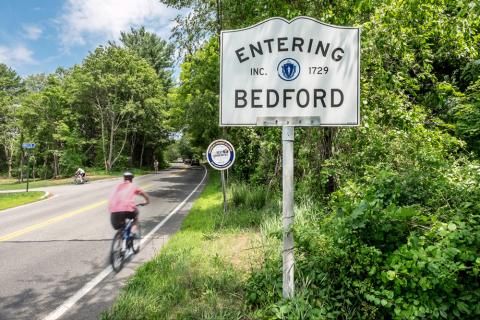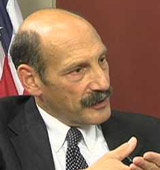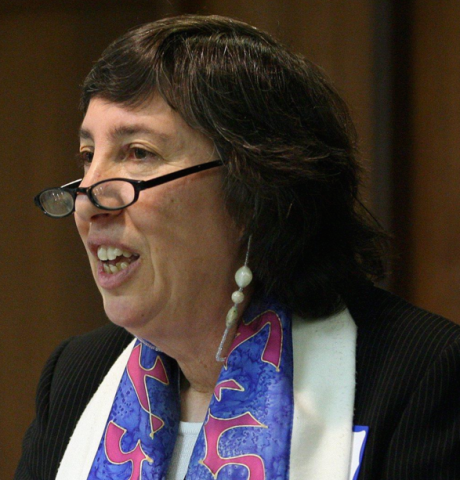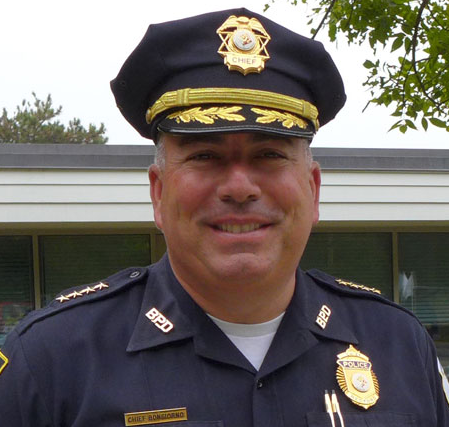
Not In Our Town’s Executive Producer Patrice O’Neill sat down with Bedford School Superintendent Jon Sills, Bedford Police Chief Robert Bongiorno, and Rabbi Susan Abramson of Temple Shalom Emeth to talk about their collaborative response and action after a series of anti-Semitic incidents at schools in Bedford, MA in March of 2014.
School Superintendent Jon Sills quickly took the lead and wrote a series of letters detailing the incidents, and called for a community forum to raise awareness about the problem, “This is not who we are. We should be judged by how we respond to these incidents, but we have to first come together and address it.”
Rabbi Susan Abramson participated in a series of meetings with Superintendent Sills, local clergy, law enforcement, and a coalition of school leaders. Together, they came up with an action plan. “We created and distributed magnets and posters that said “Love Your Neighbor: Bedford Embraces Diversity,” and we wanted to spread this around as a physical sign that people were going to stand up and be counted," said Rabbi Abramson. "It was very similar to the menorahs that people put in their windows in Billings, Montana.”
Not In Our Town Executive Producer Patrice O’Neill: Can you talk about the recent anti-Semitic incidents in Bedford, MA and how they’ve impacted the community?
Bedford School Superintendent Jon Sills: We discovered swastikas in some bathrooms at the high school and didn't immediately go public with it. Over the years, there was some misogynist graffiti, some racist graffiti, and some anti-Semitic graffiti. It doesn’t make sense to bring a lot of attention to single incidents by themselves. But when they are repeated several times, we decided that we had to take a more public stance. So a few things happened: first of all, the principal went on a morning public television show and addressed the issue and then invited everyone in the school to come together for a meeting. Teachers and students met after school to discuss this. It was not a great turn out, but it was a significant turn out. It was mostly Jewish students, which is not what we would've wanted. But what happened out of those conversations was that the administration began to be aware that there had been other kinds of hurt and other kinds of microaggressions for many years that a lot of kids had experienced growing up in Bedford, where being Jewish is quite a minority. There isn't a temple in Bedford.
"I believe strongly that when a community is confronted with the challenge of addressing ugly realities, it needs to look to its strengths, and we all must strive to be the best examples we can be of courageous, inclusive, non-judgmental behavior." Jon Sills, Superintendent, Bedford Public Schools
Patrice O’Neill: What did you learn from those conversations?
Superintendent Jon Sills: We realized that there is something more than these single incidents of hate graffiti and that there is a theme here. At the same time that the swastikas were discovered in the bathroom, some parents reported that their child, who was in elementary school, had come home and said he played a game called “Jail the Jews.” And it wasn't an actual game where they physically took kids, but they would react to a kid that they felt was obnoxious and say ‘Jail the Jews.’ This was happening in the first or second grade.
Patrice O’Neill: What action did you decide to take at that point?
 |
| Bedford School Superintendent Jon Sills |
Superintendent Jon Sills: Actually, there were other incidents like swastikas found on the playground, writings on a walkway about killing the Jews, and then there was a whole series of swastikas at the community college. I realized something is going on here, so I wrote a letter to our whole school community. We have a great relationship with our news media and I posted a series a letters to the community that were published in The Bedford Citizen. (Read the letters Superintendent Sills sent to the community about the need to respond to anti-Semitic incidents here.)
Patrice O’Neill: How did you reach out to the larger community?
Superintendent Jon Sills: We were willing to talk about it. We weren't going to shy away from the issue. We knew we had a systemic problem in the community -- it wasn't a school issue. it was a police issue, it was a community issue. The challenge was that the more the incidents and the issues became publicized, the more potential there was for copycats, so we were looking at the big picture. We were going to deal with it, but how frequently? Everytime Channel 5 or Fox News says kids in Bedford are playing “Jail the Jews,” that was so painful for Bedford, painful to have that image.
Patrice O’Neill: How did the faith community react to the news?
 |
| The logo for the "Beford Embraces Diversity" campaign |
Rabbi Susan Abramson of Temple Shalom Emeth: The first time the swastikas appeared, someone called and told me about it and we were just about to have a clergy meeting. So I called the Bedford High School Principal and I asked him to come to our clergy meeting about the swastikas and he said “I'll be right there.” The principal rushed right over, which I thought was amazing, just having had this incident, to leave the school and come to our clergy, which is on the other side of town. Everybody there was horrified, and while the principal was at the clergy meeting, he got a text message saying that it had happened again. So this was an active, ongoing situation. The clergy immediately coalesced and over the next few weeks, we got together and started this campaign called “Love Your Neighbor: Bedford Embraces Diversity.”
Patrice O’Neill: How did you share that message?
Rabbi Susan Abramson: We created and distributed magnets and posters that said “Love Your Neighbor: Bedford Embraces Diversity” and we wanted to spread this around as a physical sign that people were going to stand up to this and be counted. It was very similar to the menorahs that people put in their windows in Billings, Montana. We were also having conversations about how much we push the school and the police to make all this stuff public, and there was a little bit of controversy there cause there wasn't that trust. So I kind nominated myself to be the liaison to the police department and the school department.
Bedford Police Chief Robert Bongiorno: Rabbi Abramson played a really critical role. We were coordinating the schools, police, clergy. And you know when this kind of thing happens, people feel hurt, they feel angry, they feel upset. It kind of triggers all kinds of histories, and there really were some differences with how to move forward. The starting point was that we went public with it all. We were on TV and in the newspapers -- we were there to not only make sure that people who are Jewish citizens felt protected, and that they were our priorities, but that the rest of the community also wanted to join with them . We need to expose our underbellies, which is a difficult thing to do, and I salute Superintendent Sills for this immensely. In a time of adversity, he stepped up to the plate, he took the lead and did the right thing, and the amount of respect I have for him is enormous because of that. I learned a lot, that’s the sign of a true leader.
 |
| Rabbi Susan Abramson of Temple Shalom Emeth |
Rabbi Susan Abramson: The letters he sent were just unbelievable, they really galvanized the entire town. It was such a healthy way that he articulated what was going on in town and what the response should be. It was unwavering and he set the direction for the community, he set the direction for the police department, he set the direction for the response. But during the infancy of this, we had questions, like how much of this do you go public with? What's a copycat, the information is there, how much more do you expose? Because we were worried about copiers, and as the media began to pick up on this incident I was afraid of these hate groups coming in from across the country.
Police Chief Bongiorno: I was worried about the Westboro Baptist Church (a hate group) coming in. I had dealt with them in my prior community, so I put this on the table and I said we need to be careful with how far we go, and I told the community what we have and that we're dealing with it. Is it necessary to give them every single incident? But if we didn't disclose it all, then we could damage the trust that we needed to build and that was the challenge. But in the end there was a fine balance, and that is what Superintendent Sills was able to spearhead. He was able to unite, he was able to overcome it, and again it was the leadership of the schools that drove the bus on this.
Patrice O’Neill: What were some challenges you faced?
Superintendent Jon Sills: Part of the challenge that we talked about was that some of these incidents involved little kids who were saying things that they overhead without knowing that they were being hateful. What we were trying to wrestle with was, how much do you expose to them? And so there were people who were in the midst of thinking we were being so open, there was a small number of people, and this is where Rabbi Abramson was so helpful, who were coming after our elementary principal. They were saying she wasn't being aggressive enough. But she was dealing with K-2nd graders, and how do you frame this in a way that's a learning opportunity? So I think we prevailed, but it was very touch and go. Ultimately we called a community meeting and over 300 people came out.
Rabbi Susan Abramson: There's another aspect I wanted to bring attention to which is the intersection of the Jewish community in town and the officials in town. I have to say that the Jewish community felt like it was under some sort of siege because of all the different incidents and all the different places. It seemed like the sky was falling a little bit. So there was that initial meeting at Temple Isaiah where a lot of different people came and that was a galvanizing meeting for the Jewish community. I spoke, Superintendent Sills spoke, and another rabbi spoke, to just give everybody a sense that everybody's on top of this. We're all in this together, we're not going to let this overpower us or overcome us.
Patrice O’Neill: What interaction did you have with law enforcement?
Rabbi Susan Abramson: The Police Chief said “what can I do to make the Jewish community feel more comfortable?” So he wanted to have a meeting with the Jewish community at my house that he would come to so that he could personally speak to the Jews in town and ask how they were feeling and what we could do.
 |
| Police Chief Robert Bongiorno |
Police Chief Bongiorno: At that meeting was also the district attorney. We needed to bring her into the fold because as this was going on there were challenges within the investigation. We were trying to get information, our School Resource Officers were in the schools, so at some point we weren't so sure if we identified the suspect and if this would be a criminal issue. We were going to have people who wanted to have a suspect accountable, so we were working with the District Attorney's office and behind the scenes she's saying “ I'm researching case law, and I have two of my civil rights lawyers on this, but if we identify somebody for what we have, it doesn't lead to a criminal act under Massachusetts statute.”
Patrice O’Neill: Because it wasn't specifically aimed at a Jewish persons door or on a synagogue?
Police Chief Bongiorno: Part of this may have been a freedom of speech issue and we were running into challenges. So at the same time, I had also reached out to the FBI Boston office and spoke to their civil rights special officer in charge who is known across the country, and we had dialogue with her, and we had meetings with her and the District Attorney. But let’s rewind to this night at the rabbi's house. I wrote down fear, there was real fear. I was hearing a real fear in the community. If we identify somebody, could they take it to the next level? And that's what we were hearing loud and clear. It's a swastika today, it's a malicious symbol of hate, but where does it turn into physical violence? And where does the person’s well being become and issue, and that's what we were hearing loud and clear.
Rabbi Susan Abramson: I had my high school students there and their parents, and the kids were afraid and their parents were afraid, like, everybody was afraid. Even I was afraid. But just the sense of support that I was getting from the Police Chief and the District Attorney was comforting. It was like, "Oh my god, the District Attorney and the Police Chief are sitting in my living room."
Police Chief Bongiorno: If I could add just one tiny piece to that -- working with the schools, we had identified a person of interest who was fitting a pattern of some prior stuff, who may have been acting out. So we had identified a person of interest. As I left the rabbi's house that night, it was about 9 o clock on a Sunday night. I get in my car and I had multiple phone messages. I obviously didn't take the phone calls. It was that point when it struck me I had a call from our shift commander who said they are responding to a location and that somebody identified a Facebook page of this person of interest who was on the Facebook page with what looked like a nine millimeter. So now that takes it to another level. So I called the District Attorney and I said you're not going to believe this -- here's what we have and she said "you're kidding me" and I said no. So the person had lived outside the boundaries of Bedford. We had been working with that neighboring police department to have an immediate response and we made an immediate contact with this person. As it turns out the photo was old, it was over the summer when they were visiting their grandparent in the midwest. The gun was a replica, but it highlights the sense of urgency that we had with that moment. Here we were leaving the house saying fear, we're hearing the Jewish community is in fear based on these incidents, and then to have that when we left kind really struck home. As it turns out, we were able to figure out what that Facebook page was but we were never able to properly close that case with that person of interest.
Patrice O’Neill: Did you have any other leads?
Police Chief Bongiorno: There were other things. There was a group of high school kids caught playing a game online and using as a symbol on their game, like a salmon and swastika. That was a symbol they chose of their presence online, to play this game with each other. This was all around the same time. It was unbelievable. It was a perfect storm, and all along what we wanted to do was gear the community, especially the Bedford Jewish community, that if we identified someone and we weren't able to charge them, how were we going to deal with that? Because we were going to lose credibility, we were going to lose trust, and that's when we thought of restorative justice as a great partnership between the schools. Restorative justice is huge, and we were beginning to plant the seed to the community that if we identified somebody, police and school and town officials were on board with trying to bring that individual to restorative justice. So the community would hold the offender accountable. Repair the harm, and then hopefully have closure to that.
Patrice O’Neill: So did you assume that a young person was the perpetrator?
Police Chief Bongiorno: Yes, the indicators were that it was not an adult that snuck into the schools, but I think because we eventually had person of interest who left the area and we were pretty clear that that person was involved. It's not clear whether the things that were subsequent were copycats or not, but I think that in terms of there being some things in different parts of the community, it wasn't just one person. What we all felt was that we want to make sure that people felt safe. The deeper issues were the cultural pieces that allowed for these other smaller incidents to happen over time that were hurtful and that had gone on for too long.
Superintendent Jon Sills: Usually graffitti is individual, it's got real issues and it’s potentially dangerous, but we took to heart the whole other piece and we got 300 people out to a meeting. We created a couple of committees -- one to begin to look at how to address these issues in the community, the other to support the work we were doing in the schools, and we brought in Facing History for the first time. I knew Facing History and Ourselves well from working in Brookline and I've had former students work there, but we never had them in Bedford. So we completely revised the 6th, 7th, and 8th grade curriculum. Facing History is now at the center of our 8th grade curriculum around civil rights.
The other thing which was so neat was that so many of our Jewish residents who came forward really clearly said look, we need to deal with the anti-Semitism, but this is bigger than anti-Semitism. We want to go on record saying we are concerned about racism; we are concerned about all kinds of bigotry and prejudicial behaviors, so that was really wonderful, and that's how the school took it. We had to address the particularities of anti-Semitism, but this told us that we needed to dig deeper on all these other issues.
Learn More
Read more about recent incidents of intolerance in schools in our new blog.
Read more about this story in a feature from the Boston Globe.
Learn more about the teaching tools offered by Facing History and Ourselves.
Find ways to help young people stand up to hate and intolerance: Not In Our School.
Add new comment